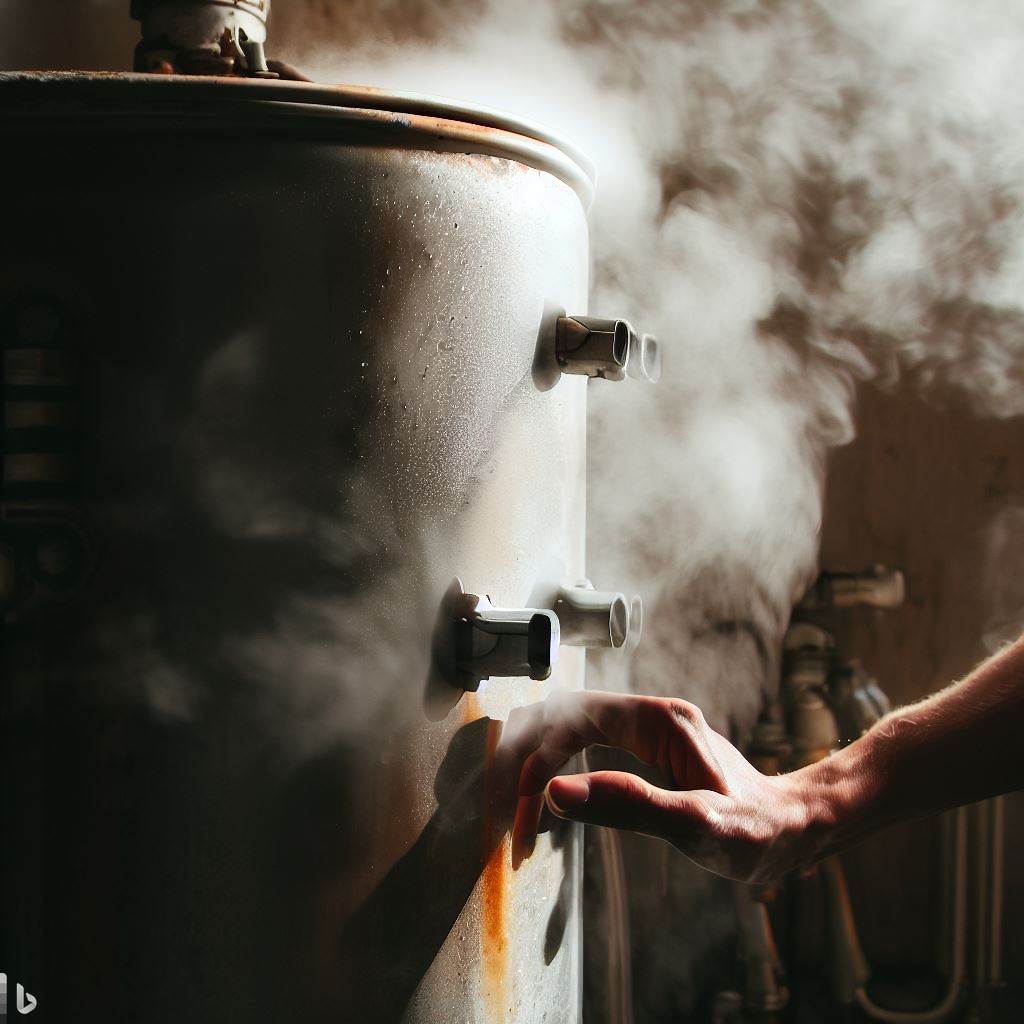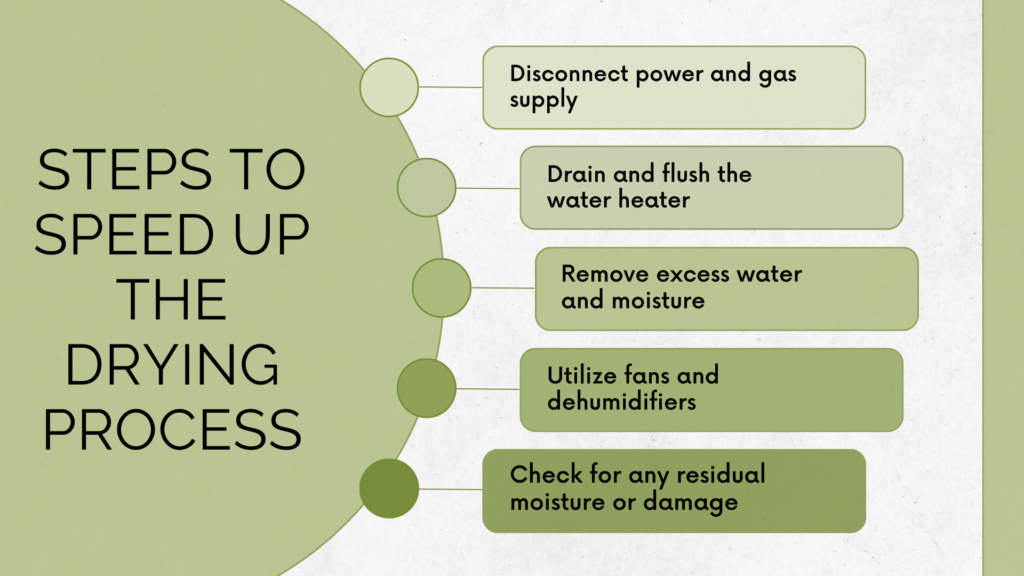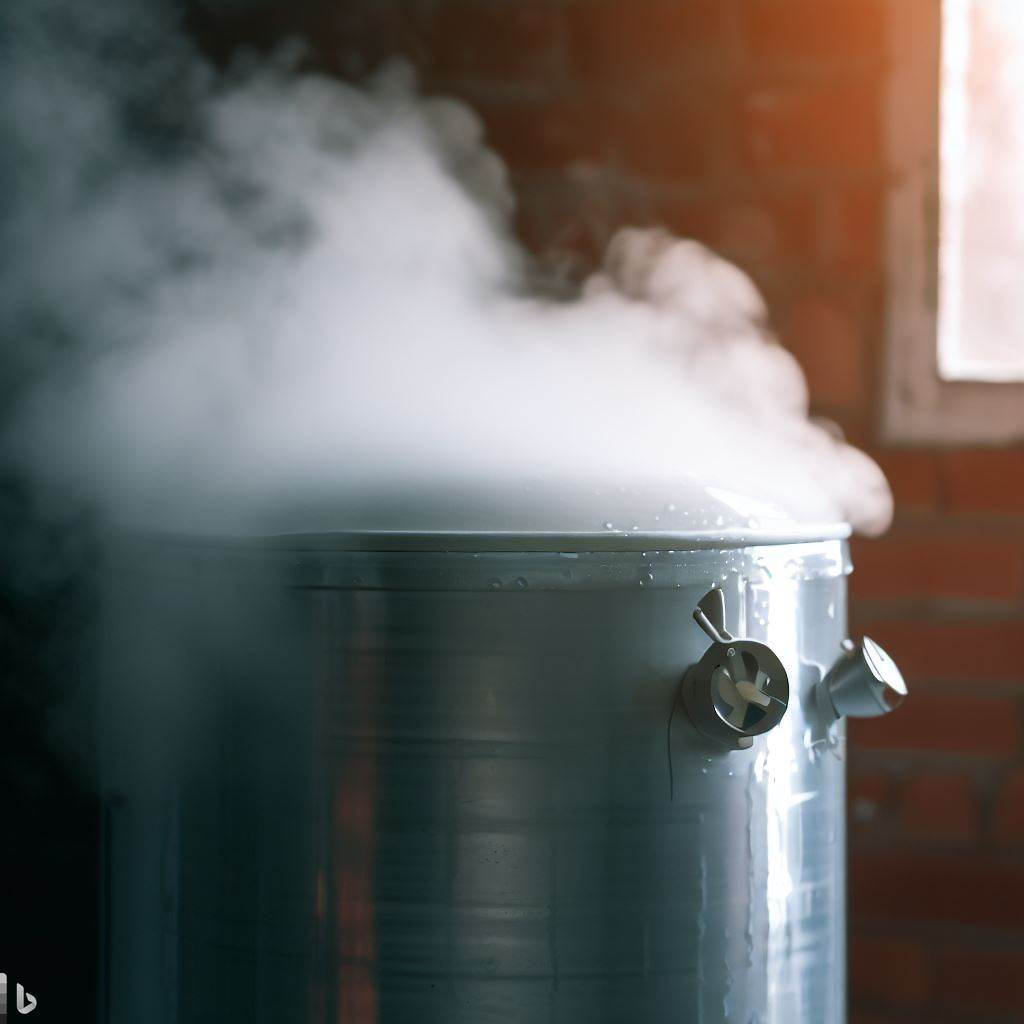Table of Contents
Running into a soggy predicament with your water heater can be unnerving. As an interesting fact, did you know it typically takes around 72 hours for areas exposed to water damage to dry? This comes as great news, especially if you’re wondering “How Long Does It Take for a Water Heater to Dry Out?” In this blog post, we’ll guide you step-by-step through the entire drying process and provide tips to expedite recovery time.
Curious? Let’s turn up the heat!

Key Takeaways
- The drying time for a flooded water heater can vary depending on factors such as the severity of water ingress, amount of water present, temperature and humidity levels, ventilation, and air circulation.
- On average, it takes a few days to a few weeks for a water heater to dry out completely.
- Thorough drying is important to prevent further damage and ensure safe operation.
- To speed up the drying process, disconnect the power and gas supply, drain and flush the water heater tank, remove excess water and moisture using towels or a wet-dry vacuum, and utilize fans and dehumidifiers to promote air circulation.
Factors Affecting the Drying Time of a Flooded Water Heater
The drying time of a flooded water heater depends on several factors, including the severity of water ingress, the amount of water present, temperature, and humidity levels, as well as ventilation and air circulation in the area.
Severity of water ingress
The severity of water ingress can drastically impact the drying time for a water heater. It’s simple physics – the more water that penetrates your unit, the longer it needs to thoroughly dry out.
For example, a slight leak might just need around 72 hours to dry completely but an instance where substantial flooding has occurred may take up to several weeks of drying. In severe cases, warm heating won’t be able to expel all the moisture absorbed by insulation and components within the heater.
Henceforth, such situations call for replacement rather than restoration. Consider professional consultation if faced with substantial floods as incorrect handling could lead to serious damage or potential risks in future usage.
Amount of water present
The amount of water present in a flooded water heater is an important factor that affects the drying time. The more water that has entered the unit, the longer it will take to dry out completely.
It’s crucial to address any excess water as soon as possible to prevent further damage and ensure a speedy recovery. Remember, the severity of the flooding can also impact other components of your home’s plumbing system, so it’s essential to assess and address all areas affected by the water damage promptly.
Temperature and humidity levels
The temperature and humidity levels play a crucial role in the drying time of a flooded water heater. Higher temperatures accelerate the evaporation process, allowing moisture to dissipate more quickly.
Similarly, lower humidity levels facilitate faster drying, as there is less moisture in the air to impede evaporation. On the other hand, colder temperatures and higher humidity can prolong the drying process.
Therefore, it is essential to maintain suitable conditions for effective drying by controlling temperature and reducing humidity through proper ventilation or using dehumidifiers if necessary.
Ventilation and air circulation
Proper ventilation and air circulation play a crucial role in the drying process of a flooded water heater. When a water heater is exposed to excess moisture, it’s important to create an environment that allows for effective evaporation.
Ensure that any windows or doors in the vicinity are open to allow fresh air to flow through. Additionally, you can use fans or dehumidifiers to enhance air movement and remove moisture from the surrounding area.
Adequate ventilation not only speeds up the drying time but also helps prevent mold growth and further damage caused by trapped moisture.
Average Time for a Water Heater to Dry Out
On average, it takes a few days to a few weeks for a water heater to dry out completely. However, thorough drying is crucial to prevent further damage and ensure safe operation. Learn how to speed up the drying process and important safety considerations in our complete guide.
Range of a few days to a few weeks
The drying time for a water heater can vary depending on the severity of the water damage and other factors. On average, it takes anywhere from a few days to a few weeks for a water heater to dry out completely.
However, it’s important to remember that thorough drying is crucial to prevent further damage or mold growth.
Factors such as the amount of water present, temperature and humidity levels, ventilation, and air circulation all play a role in determining how long it takes for a water heater to dry. In some cases, the warmth generated by the heated water can help expedite the drying process.
To speed up the drying process, there are steps you can take. First, make sure to disconnect power and gas supply before doing anything else. Drain and flush your water heater tank to remove any remaining water.
Remove excess moisture using towels or mops. Additionally, utilizing fans and dehumidifiers in the area can help circulate air and accelerate drying.
It’s important to exercise caution during this process and check for any residual moisture or signs of damage that may require professional assistance. Regular maintenance and monitoring can also help prevent future issues with your water heater.
Importance of thorough drying
Thorough drying of a flooded water heater is crucial to prevent further damage and ensure the safe and efficient functioning of the appliance. When water gets inside the tank, it can lead to rusting, corrosion, and even electrical issues if not addressed promptly.
Completely drying out the water heater helps eliminate any residual moisture that could cause long-term problems. It’s essential to remember that dry firing a water heater without refilling it can result in severe damage, leading to leaks or tank failure.
By taking the time to properly dry out your water heater after a flood or leak, you can help extend its lifespan and avoid costly repairs down the line.
Steps to Speed up the Drying Process
To speed up the drying process of a flooded water heater, follow these steps: disconnect the power and gas supply, drain and flush the water heater, remove excess water and moisture, and utilize fans and dehumidifiers.
Want to know more? Keep reading!

Disconnect power and gas supply
To start the process of drying out a flooded water heater, it is crucial to disconnect both the power and gas supply. This step ensures safety and prevents any potential hazards while working on the water heater.
By turning off the power source, you eliminate the risk of electrical shocks or damage. When it comes to gas water heaters, shutting off the gas valve will prevent any leaks or accidents from occurring during the drying procedure.
It’s important to always prioritize safety when dealing with water heater issues in order to avoid further damage and protect yourself from potential dangers.
Drain and flush the water heater
To properly dry out a flooded water heater, it is crucial to drain and flush the tank. This process helps remove any remaining water and contaminants that may have entered during the flooding.
To begin, make sure to disconnect the power and gas supply for safety reasons. Then, locate the hot water tank drain valve and attach a garden hose to it. Open the valve and let the water run out until it stops flowing.
Flushing your water heater not only helps with drying but also aids in clearing out any sediments or debris that could affect its performance in the long run.
It’s important to note that draining a water heater can take about 15 to 30 minutes depending on its size. Additionally, keep in mind that dry firing – running a water heater without any water inside – can cause severe damage and potentially lead to leaks.
Therefore, always ensure there is enough water in the tank before turning it back on after drying.
Remove excess water and moisture
To speed up the drying process of a flooded water heater, it is crucial to remove excess water and moisture. Start by disconnecting the power and gas supply to ensure safety. Then, open the drain valve and let the water flow out through a garden hose.
Next, use towels or a wet-dry vacuum to absorb any remaining water inside the tank. It’s important to remember not to dry fire the water heater by running it without water, as this can cause damage.
To further remove moisture from the surrounding area, utilize fans and dehumidifiers. Place them near the affected area to promote air circulation and aid in evaporation.
Regularly check for any residual moisture or signs of damage throughout this process. If you’re unsure about any step or encounter complications, consider consulting a professional for assistance.
Utilize fans and dehumidifiers
To speed up the drying process of a flooded water heater, you can utilize fans and dehumidifiers. These tools help to increase air circulation and remove excess moisture from the surrounding environment.
By placing fans around the water heater, you can promote faster evaporation of any remaining water. Additionally, using a dehumidifier will help to reduce humidity levels in the area, preventing further moisture damage and aiding in the drying process.
Remember to ensure proper ventilation during this time for optimal results.
Check for any residual moisture or damage
After the water heater has been allowed sufficient time to dry out, it’s essential to thoroughly check for any lingering moisture or damage. Make sure the exterior of the heater is completely dry to avoid any potential electrical hazards.
Inspect all connections and fittings for signs of corrosion or water damage. In addition, examine the insulation around the tank for wet spots or mold growth, as this can compromise its effectiveness and efficiency.
Remember that if you discover any significant issues or are unsure about how to proceed, it’s always best to consult a professional plumber who can assess and address any potential concerns.
Safety Precautions and Considerations
When dealing with a flooded water heater, it is important to prioritize safety. If you are unsure about any step of the drying process, it is best to consult a professional for assistance. Gas water heaters may require inspection before relighting, and caution should be exercised to prevent any accidents or further damage.
Regular maintenance and monitoring are also crucial in preventing future issues. To learn more about the safety precautions and considerations when drying out a water heater, continue reading the full article.
Consult a professional if unsure
If you’re unsure about the drying process or how to handle a flooded water heater, it is always best to consult a professional. They have the expertise and knowledge to assess the severity of the damage and guide you through the necessary steps for effective restoration.
A professional can also ensure that any potential safety hazards, such as gas leaks or electrical issues, are addressed properly. It’s important not to attempt any repairs or maintenance if you’re uncertain, as this may cause further damage to your water heater or put your safety at risk.
Consulting a professional will give you peace of mind knowing that your water heater will be handled correctly and efficiently.
Gas water heaters and the need for inspection
Gas water heaters require additional caution and inspection after being subjected to flooding or water damage. Unlike electric water heaters, gas models have combustion components, such as burners and control valves, which can be affected by excess moisture.
It is crucial to ensure that these components are thoroughly dried out before relighting the pilot light or using the gas supply again.
Excess moisture in a gas water heater can lead to rusting, corrosion, and even damage to the thermocouple – a critical safety feature that prevents gas leaks. Therefore, it is recommended to consult a professional plumber or HVAC technician who specializes in gas appliances for an inspection after flooding occurs.
They will assess any potential damage and take appropriate steps to dry out the unit properly before restoring its functionality.
Caution when relighting a flooded water heater
Relighting a flooded water heater requires caution to ensure safety. After the water heater has been dried out, it is important not to rush into relighting the pilot light without proper inspection.
Check for any visible signs of damage or corrosion before proceeding. If there are any doubts or concerns, it is best to consult a professional plumber or technician who can assess the situation and take appropriate measures.
Gas leaks and other hazards can occur if relighting is done improperly, so always prioritize safety when dealing with a flooded water heater.
Importance of regular maintenance and monitoring
Regular maintenance and monitoring of your water heater are essential to ensure its optimal performance and longevity. By taking proactive measures, you can not only prevent potential issues but also detect any problems early on before they escalate into major costly repairs.
Regular maintenance includes checking for any leaks, inspecting the pressure relief valve, flushing out sediment buildup, and ensuring proper insulation.
An efficiently maintained water heater will not only save you money on energy bills but also provide a consistent supply of hot water when you need it most. Additionally, by monitoring your water heater regularly, you can identify signs of damage or wear and tear that may require professional attention.
This way, you can address any issues promptly and avoid unexpected breakdowns or disruptions to your hot water supply.
Remember that some tasks such as checking the pressure relief valve should be performed by a qualified plumber or technician who is familiar with the specific make and model of your water heater.
Their expertise will help ensure that all safety precautions are taken during maintenance procedures.

FAQ
1. How long does it take for a water heater to dry out?
The time it takes for a water heater to dry out can vary depending on factors such as the size of the tank, the amount of water present, and the temperature and humidity conditions in the area. Generally, it can take anywhere from a few hours to several days for a water heater to fully dry out.
2. Why would a water heater need to be dried out?
A water heater may need to be dried out if there has been a leak or flooding that resulted in excess water entering the tank. Drying out the tank is important to prevent corrosion and damage to the heating elements.
3. Can I speed up the drying process for my water heater?
There are steps you can take to help speed up the drying process for your water heater. These include draining all remaining water from the tank, opening windows or using fans to improve air circulation around the unit, and using absorbent materials like towels or dehumidifiers near the tank to soak up moisture.
4. Are there any risks involved in drying out a water heater?
While drying out a water heater is generally safe, there are some risks involved if not done properly. It’s important to ensure that all power sources are turned off before starting the drying process, as electrical components could pose an electrocution hazard if exposed to moisture. Additionally, if you’re unsure about how best to dry out your specific model of water heater, it’s recommended to seek assistance from a professional plumber or technician who can provide expert guidance.
Conclusion
In conclusion, the drying time of a water heater after being flooded can vary depending on various factors such as the severity of water ingress and the amount of water present. On average, it may take anywhere from a few days to a few weeks for a water heater to completely dry out.
It is important to prioritize thorough drying and take necessary safety precautions during this process. By following proper steps and seeking professional help when needed, you can ensure the efficient restoration of your water heater’s functionality.
